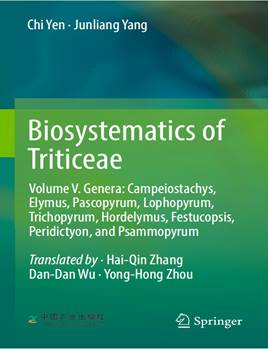Biosystematics of Triticeae Volume V.
作者: 刘宇娇 审稿人:魏育明 时间: 2022-05-30 点击次数:次
小麦族生物系统学第五卷(英文版)出版
书名:Biosystematics of TriticeaeVolume V.
Genera: Campeiostachys, Elymus, Pascopyrum, Lophopyrum, Trichopyrum, Hordelymus, Festucopsis, Peridictyon, and Psammopyrum

作者:颜济,杨俊良
译者:张海琴,吴丹丹,周永红
出版商:Springer Singapore
出版时间:2022
eBook ISBN:978-981-19-0015-0
共712页
About this book
This book review and rearrange the research data of Triticeae published over hundreds of years, applying a modern scientific approach. Triticeae is an important tribe in the grass family (Peaceae). It includes the major cereal crops, such as wheat, barley and rye, in addition to many valuable forage crops found in different genera, such as Elymus, Agropyron, Pasthyrostachys, and Leymus. The knowledge of appropriate Triticeae taxonomy and biosystematics will serve as genetic breeding of wheat, barley, rye and forage grass. The authors attempted to remain the truth and remove the false for deriving a more natural biosystematics of Triticeae.
This book covers taxonomy, cytogenetics, and molecular phylogeny. It summarizes the biosystematics of Triticeae with comprehensive and updated data. This book is divided into five volumes (Volumes 1- 5), and includes 30 genera, 2 subgenera, 464 species, 9 subspecies, and 186 varieties in Triticeae. Volume 5 introduces nine perennial genera in Triticeae: Campeiostachys, Elymus, Pascopyrum, Lophopyrum, Trichopyrum, Hordelymus, Festucopsis, Peridictyon, and Psammopyrum.
Elymus (StH), Campeiostachys (StYH), Lophopyrum (E), and Trichopyrum (ESt)are polymorphic genus. They show similar morphological characters, and it is difficult to distinguish them based merely on morphological variation. Pascopyrum (StHNsXm), Hordelymus (XoXr), Festucopsis (L), Peridictyon (Xp), and Psammopyrum (EL) are small genera, mostly monotypic genera.
This book can serve as highly qualified, valuable, and convenient handbooks for audiences who are interested in Triticeae. This book also includes many illustrations, in addition to the description, to help the audience understand, morphological features of the concerned taxa, which makes the explanation more precise and obvious. It is a useful tool to understand the relationship among species in Triticeae.


